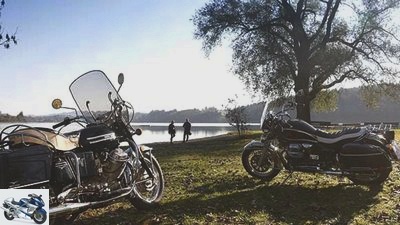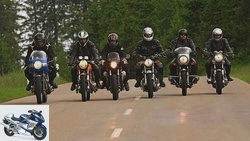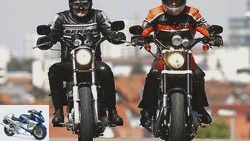Menus

Moto Guzzi
On the move: Moto Guzzi California and California Vintage
California Dreams
Content of
In the 1970s, the Beach Boys introduced a new, dynamic lifestyle, celebrated the virtues of California, surfed the Pacific on their boards and across the USA on their motorcycles.
Jahn
The Cali I (back) set standards in terms of touring back then and still cuts a fine figure today.
First and foremost, the Beach Boys sang an American lifestyle of freedom and independence that manifested itself in American motorcycles: wide handlebars, comfortable, upright seating position, expansive seat, legs relaxed on running boards. This is how Harley-Davidson understood how to convert the dream of freedom on two wheels into great dollars. The products from Milwaukee suggested the playful overcoming of long distances beyond the American borders – inside, outside the USA – and, like Easy Rider in 1969, created the illusion of completely escaping the petty-bourgeois everyday life on two wheels. A type of motorcycling that is touted as cruising these days.
Moto Guzzi wanted to participate in the economic success of this movement on the American market, especially since a suitable drive was already on the shelf. Ingegnere Cesare Carcano had already developed a two-cylinder 90-degree V-engine in the 1960s, which was originally intended for the Fiat 500 and which ultimately powered an all-terrain tricycle for the Italian Ministry of Defense. Since the Italian police and military authorities needed replacements for the aging Falcone single-cylinder, the two-cylinder was also available in a further developed form for a street motorcycle. The first civilian prototype with 704 cm³ was shown in December 1965 as a real tourer at the Milan exhibition. But it wasn’t until 1967 that the first appeared "V7" named motorcycles at the dealers and went as V7 Special to the Italian police units and the military.
In 1971 the Los Angeles Police Department decided to use Moto Guzzi as well as Harley-Davidson. The V7 Special was ideal for this purpose: its sweeping window and the wide, raised handlebar hit the nerve of the American clientele and prepared the breeding ground for the California. Moto Guzzi produced a small number of the V7 California with 750 cm³, running boards, single seat and panniers especially for the United States. In a larger series, the California came onto the market with the improved technology and displacement of the 850 GT. It too had the expansive seat, a luggage rack and two fiberglass side pockets. In 1971 Moto Guzzi presented the new concept to the European public at the trade fair in Milan. It was not only well received in the USA, but also survived Moto Guzzi’s economic roller coaster to this day thanks to a committed clientele in constant development.
Leaning casually on their chrome-plated, wide side stands, 35 years after the appearance of the first model, two California sparkles in the autumn sun: the California 850 from collector Jurgen Hoch and the current vintage, which was provided to us by dealer Lothar Heiler from Niedersonthofen – not to surf through the USA, but to glide through the autumnal Allgau, which is dressed in the yellow and rust tones of the Indian summer.
At first glance, the viewer may not believe that there are 35 years between the two: black paintwork with white stripes, sweeping, chrome-plated fenders, black seat with white flanks, the two black luggage bags, the chrome-plated luggage rack, four chrome-plated crash bars and spoked wheels, everything as usual. The generational difference only becomes apparent on closer inspection. Modern technology first and foremost catches the eye in the area of brakes: the double-duplex drum brake from our own production had to give way to modern disc brakes with four-piston fixed calipers. The chassis including spring elements and the engine, meanwhile 1100 cm³ and 73 HP strong, have endured a lot of detailed work. This also applies to the transmission. At least when it comes to the tires, the designers have obviously resorted to classic dimensions for reasons of appearance and handiness.
When looking at the shapes, the master model scores with its clearer lines. The elongated tank blends in more harmoniously with the concept than the drop-shaped structure of the new ones sloping down sharply to the rear. The rounded shapes of the cylinders and heads also fit better into the overall picture than the angular counterparts of the modern era.

Tourer
On the move: classics of the 70s
Europe wheel
read more
Driving impressions
Jahn
On the Cali I, your hands slide calmly to the handlebars, your legs rest relaxed on the running boards.
But let’s let the inner values come into their own: The driver doesn’t just climb onto the old California, but takes a seat, almost dignified, as if on a throne at a gala dinner. Immediately you feel good, your hands slide gently to the handlebars. The legs rest in a relaxed angle on the running boards, and the big tour can begin. Big surprise when switching: The new ones are the handlebars-
end far away from your body, you sit deeper in the seat and bend your knees more strongly. The ergonomics rating clearly goes to the old lady.
But then the vintage shows its advantages. The clutch disengages with little manual force, and the gears engage easily and cleanly. Not so with Uhrahn: The clutch requires the finger strength of a free climber, only separates on the last millimeter of lever travel and then only with unwilling plucking. A behavior that already occurred with the first V7 in the endurance test by Das MOTORRAD. Even a modified drive plate could not permanently solve the problem.
As usual from Guzzi, a protruding rocker switch should make it easier to sort the gears, but the claws only find their position with force and the appropriate lever path. Finding the idle turns into a game of chance because of the poorly separating clutch. It is best to take the neutral position when rolling out. Likewise, perfect downshifts require targeted double-declutching, but it’s all just a matter of getting used to. The new one switches much more comfortably, also using a rocker switch. With little force, the gears lock cleanly.
The old lady shows her strengths on the move. The V2 pulls through powerfully from idle speed. The sufficiently strained image of surfing on the torque wave is gaining in importance. Turning out the gears does not help and is not defined due to the lack of a rev counter. Thanks to its beefy characteristics, the engine could even have done without fifth gear, which was introduced with the 850. Suddenly the California proves its qualities and reveals its identity. Completely without hectic, the California pulls through under the sonorous humming of the V-engine, shifting is only necessary on steep inclines. Suddenly the driver’s stress falls away like the leaves in autumn. The Guzzista has time to enjoy its surroundings, operation becomes child’s play.
The slogan "Driving in its most beautiful form" was occupied by another manufacturer, but it applies to the 850 California at least as much. Despite its 276 kg full tank, the Guzzi can be steered extremely agile thanks to its low center of gravity, the longitudinal crankshaft and the narrow tires via the wide handlebars and shines with its neutral handling. Even on a bad road surface, the chassis teeters in its aging, underdamped suspension elements, but the Cali I remains predictable even in an inclined position. In addition, the large screen offers outstanding wind protection. Glide at 100 km / h, enjoy the Allgau in its full autumn regalia, seldom has motorcycling been more relaxed.
The new one celebrates serenity in a related way. The injection engine offers a similar form of torque development, but it can do everything one or two levels better: noticeably more powerful in the pulling force, and in the upper area it turns much more freely – as can be seen on the rev counter. The pitch is very similar to that of the old carburetor V2, maybe a bit more aggressive, less dull. The current engine sounds more dominant, especially at higher speeds. The spring elements are better damped and keep the new Cali in balance at all times, even on bad roads. At most, it tends to be slightly restless in fast corners, but that is neither the domain of ancestors nor grandsons. In terms of handiness, the new one cannot keep up with the old one, nor can it convey the confident driving experience in the same way. The uncomfortable seating position, the poorer wind protection – turbulence in the helmet area already disturbs well-being at 100 km / h – and the impression of being decoupled from the front wheel, practically directing the motorcycle from the back seat, make the unconditional nonchalance of the elderly miss
Everyday life and security
Glide along at 100 km / h, enjoy the surroundings: seldom has motorcycling been more relaxed.
This, however, quickly evaporates when it comes to slowing down the pace in front of an obstacle. The front brake of the 850 is extremely unwilling to work, even with
high hand strength. In contrast to its predecessor, the V7, the California already had a double duplex brake, which was also used in the V7 Sport. But unlike other designs, the in-house brake was never known for its outstanding performance. To save our honor, it should be said that our California model must have seen better days, because less braking is actually not possible. It is advisable to drive with foresight, for miles. The rear brake alone reduces the permanent risk of collision in an emergency.
In this respect, the new Cali aggressively displays 30 years of progress: the front brake requires a little more manual force for proper deceleration, but then only one of the two discs comes into action. The vintage, on the other hand, has the foot brake, which acts as a Moto Guzzi-typical integral brake on one of the two front and rear discs, almost playfully under control with little pedal force.
Even in disciplines that are taken for granted today, such as light output and operating elements, the vintage 30 years of development cannot be denied. The old alternator, which is located between the cylinders and is driven by a V-belt, quickly reaches its limits when the permanent light is switched on – a problem that is alien to the new one with the generator on the crankshaft stub.
But do 35 years of progress also mean a generation leap in terms of the feel-good factor? Of course, wellbeing includes safety standards with which the new one can shine. But the core of the concept is determined by the charisma and flair that the California exudes while driving. The old is in no way inferior to the new, on the contrary: The more comfortable seating position, the more direct feeling towards the motorcycle and the better wind protection ensure more relaxation and a more intense experience.
And what about the engine? Of course, you can never have enough power, and high torque is always good for relaxed surfing. On the other hand, the performance of the old ones is always sufficient for their preferred profession. It set standards in terms of touring back then and still looks great today. It was, so to speak, the forerunner of the European form of cruising, and even in the spoiled 21st century you don’t need a 200 rear tire, a two-meter wheelbase or a two-liter displacement.

Naked bike
On the move: Harley-Davidson XR 1000 / XR 1200
Sportsmanship
read more
Technical specifications
Jahn
Moto Guzzi California 850.
Moto Guzzi California 850
Engine: Air-cooled two-cylinder four-stroke 90-degree V-engine, two valves per cylinder, operated via a central camshaft, tappet, push rods and rocker arm, bore 83 mm, stroke 78 mm, displacement 844 cm³, compression 9.2: 1, 55 HP at 6100 rpm, Dell’Orto carburetor, VHB 29 CD / CS, Ø 29 mm
Electrical system: E-starter, battery 12 V / 32 Ah, contact-controlled battery coil ignition, AC alternator, 300 W.
Power transmission: Two-disc dry clutch, dog-shift five-speed gearbox, secondary drive: cardan
Landing gear: Double loop frame made of tubular steel, front telescopic fork, hydraulically damped, rear swing arm made of tubular steel, two suspension struts, wire-spoke wheels with aluminum high-shoulder rims, front tires 4.00 x 18, rear tires 4.00 x 18, front double duplex drum brake, Ø 220 mm, rear duplex drum brake, Ø 220 mm
Mass and weight: Weight 276 kg, tank capacity 22.5 liters, wheelbase 1470 mm
Driving performance: Top speed 175 km / h
Price: 7700 Mark (1972)
Manufacturer: Moto Guzzi, S. E. I. M. M., Mandello del Lario, Italy
Jahn
Moto Guzzi California Vintage.
Moto Guzzi California Vintage
Engine: Air-cooled two-cylinder four-stroke 90 degree V-engine, two valves per cylinder, operated via a central camshaft, hydraulic valve lifters, bumpers and rocker arms, bore 92 mm, stroke 80 mm, displacement 1064 cm3, compression 9.8: 1, 73 HP at 6400 rpm, Weber-Marelli intake manifold injection, Ø 40 mm
Electrical system: E-starter, battery 12 V / 30 Ah, contactless transistor ignition, three-phase alternator, 350 W.
Power transmission: Two-disc dry clutch, dog-shift five-speed gearbox, secondary drive: cardan
Landing gear: Double loop frame made of tubular steel, front telescopic fork, hydraulically damped, rear swing arm made of tubular steel, two spring struts, wire-spoke wheels with steel rims, front tires 110/90 VB 18, rear tires 140/70 VB 17, front double disc brake, Ø 320 mm, four-piston fixed calipers, rear Disc brake, Ø 280 mm, double piston caliper, integral brake system
Mass and weight: Weight 290 kg, tank capacity 19 liters, wheelbase 1560 mm
Driving performance: Top speed 185 km / h
Price: 15,270 euros
Manufacturer: Moto Guzzi, p. A. Mandello del Lario, Italy
Related articles
-
Driving report Moto Guzzi California Vintage
Gargolov Driving report Moto Guzzi California Vintage Saddle tractor Moto Guzzis with large, wide saddles have been known as California for 35 years. And…
-
Driving report Moto Guzzi Breva V 1100
fact Driving report Moto Guzzi Breva V 1100 Una Storia Italiana The story of the long-announced Moto Guzzi Breva V 1100 is a typically Italian one: of…
-
On the move: BMW R 100 S, Honda CB 900 F Bol d’Or, Moto Guzzi Le Mans I.
fact On the move: big bikes from the 70s BMW R 100 S, Honda CB 900 F Bol d’Or, Moto Guzzi Le Mans I. Content of At the turn of the decade, MOTORRAD…
-
Impression: Harley-Davidson Road King Classic and Moto Guzzi California Vintage
Artistic Impression: Harley-Davidson Road King Classic and Moto Guzzi California Vintage There’s only two directions here, boy! With two air-cooled …
-
Moto Guzzi conversion Doc Jensen Racer No. 59
Siemer 20 pictures Fred Siemer 1/20 Moto-Guzzi conversion Doc Jensen Racer No. 59. Fred Siemer 2/20 Moto-Guzzi conversion Doc Jensen Racer No. 59. Fred Siemer 3/20 …
-
Moto Guzzi V7 Special and Moto Guzzi V7 II Special in comparison test
fact 38 pictures fact 1/38 Moto Guzzi V7 Special and Moto Guzzi V7 II Special in a comparison test. fact 2/38 … the Moto Guzzi V7 II Special scores with …
-
Moto Guzzi 850 GT California and California Vintage compared – motorcycle myths
Brands, myths and engines: Moto Guzzi 850 GT California and California Vintage in comparison Nice coincidence: In 1965 the mums published …
-
Driving report Moto Guzzi Griso 8V
Bilski Driving report Moto Guzzi Griso 8V With two game four Moto Guzzi traditionally relies on two cylinders. Classically air-cooled, lying lengthways,…
-
Driving report Moto Guzzi MGS-01 Corsa
Gori Driving report Moto Guzzi MGS / 01 Corsa Adler learns to fly In autumn she was one of the stars of Intermot. The MGS / 01 study caused a sensation…
-
Driving report Moto Guzzi California 1400 Custom
Manufacturer 39 photos fact 1/39 Generation meeting at Guzzis. The Moto Guzzi California 1400 from 2013 in comparison with its ancestor, the 850 T3 from…